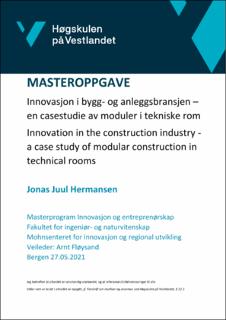| dc.contributor.author | Hermansen, Jonas Juul | |
| dc.date.accessioned | 2021-08-24T05:44:27Z | |
| dc.date.available | 2021-08-24T05:44:27Z | |
| dc.date.issued | 2021 | |
| dc.identifier.uri | https://hdl.handle.net/11250/2770837 | |
| dc.description | Masterprogram i innovasjon og entrepenørskap.
Fakultet for ingeniør- og naturvitskap/ Mohnsenteret for innovasjon og regional utvikling/ Høgskulen på Vestlandet, campus Bergen. | en_US |
| dc.description.abstract | Bygg- og anleggsbransjen er veletablert og har klare tradisjoner for hvordan samarbeid og konkurranser foregår, noe som påvirker hvordan dagens løsninger utføres. I senere tid har bransjen startet å benytte seg av moduler og prefabrikasjon i ulike deler av et bygg. Likevel henger de tekniske rommene i stor grad igjen i gamle tradisjoner og blir bygget slik man alltid har gjort. Det er derfor utarbeidet en overordnet problemstilling som omhandler hvilke drivere og barrierer som er til stede for å øke modulbruken i tekniske rom. For å belyse problemstillingen er det utarbeidet fire forskningsspørsmål som illustrerer utfordringene i bransjen. Forskningsspørsmålene tar utgangspunkt i hva som kjennetegner Veidekkes praksis ved bygging av tekniske rom, hvordan stiavhengighet påvirker løsninger, hvordan innovasjonspraksisen kan reorganiseres for å stimulere til økt innovasjon og i hvilken grad moduler kan utvikle seg til en disruptiv innovasjon. For å opplyse forskningsspørsmålene er det utført semi-strukturelle dybdeintervjuer med forskjellige aktører i bygg- og anleggsbransjen. Dybdeintervjuene vil, i kombinasjon med en teorigjennomgang, legge grunnlaget for en diskusjon rundt problemstillingen og forskningsspørsmålene. | en_US |
| dc.description.abstract | The construction industry is well established and has clear traditions for how cooperation and competitions take place, which affects how current solutions are carried out. Recently, the industry has started to use modules and prefabrication in different parts of a buildings. However, these kinds of developments have not reached technical rooms, which remain entrenched in tradition. An overall thesis question has therefore been formed that questions which drivers and barriers there are to increasing the use of modules in technical rooms. To shed light on the thesis question, four research questions have been prepared that illustrate the challenges in the industry. These are based on current practice in building technical rooms, how path dependence affects solutions, how innovation practice can be reorganized to stimulate increased innovation and to what extent modules can develop into a disruptive innovation. In order to answer the research questions, semi-structural interviews have been conducted with various industry professionals. A combination of in-depth interviews and theoretical review facilitates the discussion of both thesis and research questions. | en_US |
| dc.language.iso | nob | en_US |
| dc.publisher | Høgskulen på Vestlandet | en_US |
| dc.rights | Navngivelse 4.0 Internasjonal | * |
| dc.rights.uri | http://creativecommons.org/licenses/by/4.0/deed.no | * |
| dc.subject | Bygg- og anleggsbransjen | en_US |
| dc.subject | Modul | en_US |
| dc.subject | Innovasjonsprosesser | en_US |
| dc.subject | Stiavhengighet | en_US |
| dc.subject | Disruptive innovasjoner | en_US |
| dc.subject | Drivere og barrierer | en_US |
| dc.subject | The construction industry | en_US |
| dc.subject | Modular construction | en_US |
| dc.subject | Innovation processes | en_US |
| dc.subject | Path dependence | en_US |
| dc.subject | Disruptive innovations | en_US |
| dc.subject | Drivers and barriers | en_US |
| dc.title | Innovasjon i bygg- og anleggsbransjen – en casestudie av moduler i tekniske rom | en_US |
| dc.title.alternative | Innovation in the construction industry - a case study of modular construction in technical rooms | en_US |
| dc.type | Master thesis | en_US |
| dc.description.localcode | INN599 | en_US |

